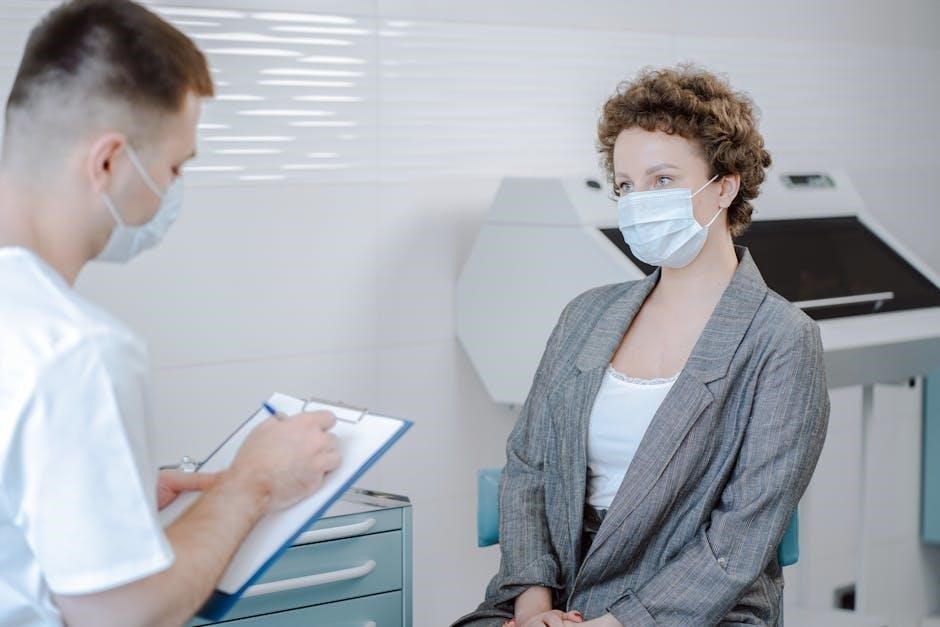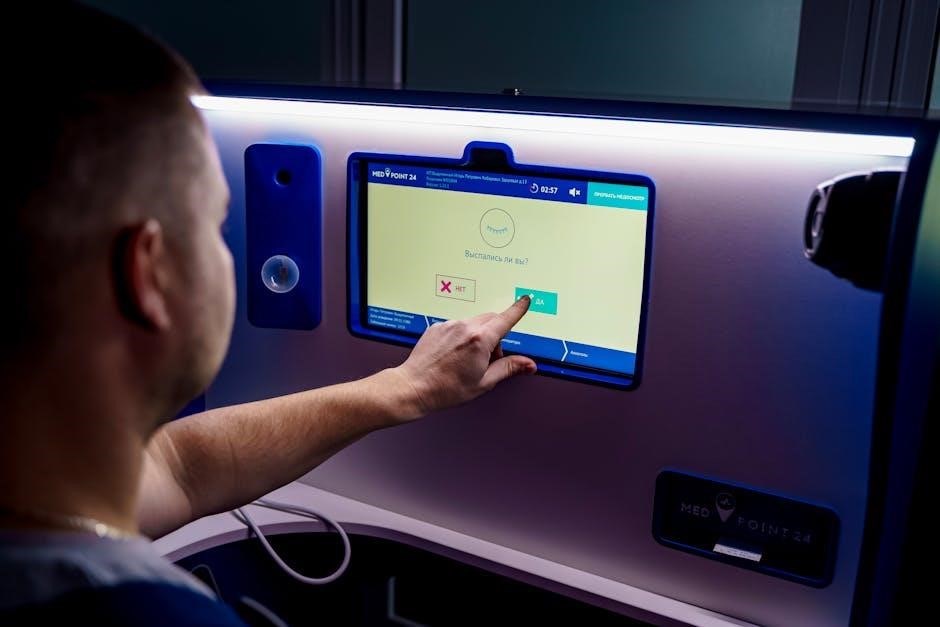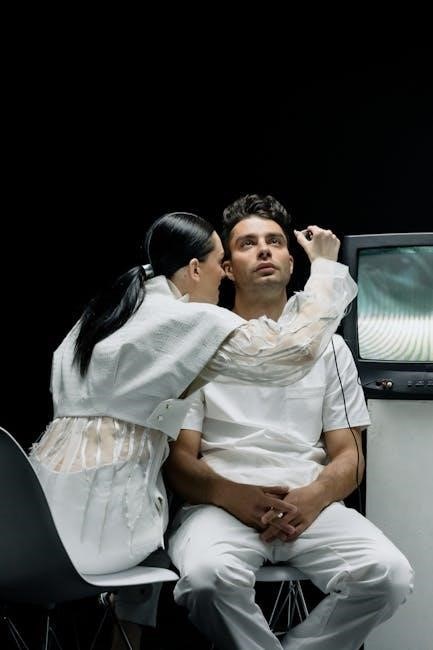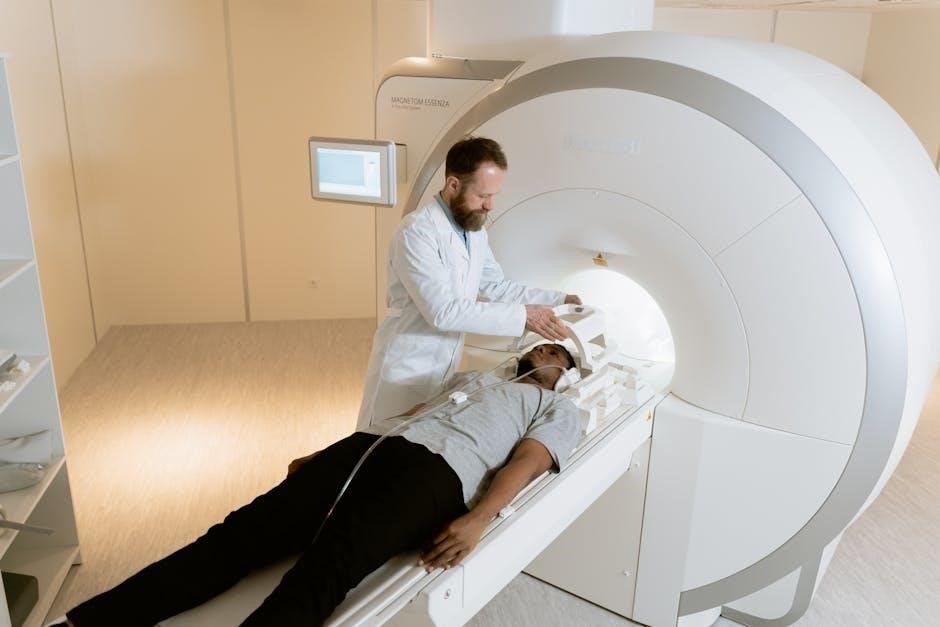
NREMT Medical Assessment Scenarios are structured, real-life simulations designed to evaluate and enhance EMS professionals’ skills in patient evaluation and care. These scenarios cover various emergencies.
1.1 Overview of the Importance of Medical Assessment Scenarios
Medical assessment scenarios are critical for EMS professionals, as they simulate real-life emergencies, enabling practitioners to refine their diagnostic and treatment skills. These scenarios cover diverse conditions, from respiratory distress to cardiac arrest, ensuring comprehensive preparedness. By practicing primary and secondary surveys, history taking, and SOAP note documentation, EMS providers enhance their ability to deliver accurate and timely care. Regular engagement with these scenarios improves decision-making, communication, and patient outcomes, making them indispensable for professional development and certification readiness.
1.2 Purpose of NREMT Medical Assessment Scenarios
The primary purpose of NREMT Medical Assessment Scenarios is to evaluate and enhance the clinical skills of EMS professionals. These scenarios provide realistic simulations of emergencies, allowing practitioners to apply their knowledge in controlled environments. By focusing on patient assessment, history taking, and decision-making, they ensure that EMS providers can deliver effective care under pressure. These scenarios also prepare candidates for certification exams, ensuring they meet the National Registry’s standards for patient evaluation and treatment. Regular practice with these scenarios builds confidence and competence, essential for real-world applications.
Key Components of NREMT Medical Assessment
The NREMT Medical Assessment involves primary and secondary surveys, history of present illness, past medical history, and documentation using SOAP notes for thorough patient evaluation.
2.1 Primary Survey: Initial Patient Assessment
The primary survey is the first step in patient evaluation, focusing on identifying life-threatening conditions. It includes assessing airway, breathing, circulation, disability, and exposure. This rapid assessment ensures immediate interventions for critical issues like compromised airways or severe bleeding. EMS professionals use standardized techniques to evaluate the patient’s overall condition quickly and effectively, prioritizing care based on the most urgent needs identified during this initial phase. Proper execution of the primary survey is crucial for patient outcomes in emergency situations.
2.2 Secondary Survey: Detailed Patient Evaluation
The secondary survey involves a thorough, head-to-toe evaluation of the patient to identify specific injuries or illnesses. It includes assessing the history of present illness (HPI), past medical history, medications, and last oral intake. Physical examination focuses on affected body systems, using techniques like inspection, palpation, and auscultation. This step also involves documenting findings using SOAP notes for clear communication. The secondary survey ensures a comprehensive understanding of the patient’s condition, guiding further treatment and transport decisions. It follows the primary survey once immediate threats are stabilized.
2.3 History of Present Illness (HPI) and Past Medical History
The History of Present Illness (HPI) and Past Medical History (PMH) are crucial components of patient assessment. The HPI details the onset, duration, and characteristics of the patient’s current condition, while the PMH includes pre-existing medical conditions, allergies, and medications. This information helps EMS providers identify potential causes of the illness or injury and tailor treatment. Accurate documentation of HPI and PMH ensures effective communication with healthcare teams and informs the patient’s care plan. These elements are essential for a comprehensive secondary survey.

Common Medical Assessment Scenarios
Common scenarios include respiratory distress, cardiac emergencies, and trauma cases. These simulations prepare EMTs to assess and manage conditions like asthma attacks, chest pain, and injuries effectively.
3.1 Respiratory Emergencies: Asthma and COPD Scenarios
Respiratory emergencies, such as asthma attacks and COPD exacerbations, are critical scenarios for NREMT training. These simulations focus on rapid assessment of airway patency, breathing rate, and oxygen saturation. EMTs must identify signs of distress, such as wheezing, coughing, or use of accessory muscles. Interventions include oxygen therapy, bronchodilator administration, and positioning to improve breathing. Scenarios often involve patients with persistent coughing or shortness of breath, requiring prompt documentation and communication of findings. Mastery of these scenarios ensures effective care for respiratory distress cases.
3.2 Cardiac Emergencies: Chest Pain and Cardiac Arrest Scenarios
Cardiac emergencies, including chest pain and cardiac arrest, are high-stakes scenarios in NREMT training. These simulations emphasize quick assessment of cardiac rhythm, blood pressure, and oxygen levels. EMTs must distinguish between stable angina and myocardial infarction, and recognize signs of cardiac arrest, such as unresponsiveness and absence of pulse. Interventions include defibrillation, CPR, and administering medications like aspirin or epinephrine. Scenarios often involve patients with radiating pain or sudden collapse, testing EMTs’ ability to act swiftly and accurately. Proficiency in these scenarios is crucial for improving patient outcomes.
3.3 Trauma Scenarios: Injury Mechanisms and Assessment
Trauma scenarios in NREMT training focus on evaluating injuries from mechanisms like blunt trauma (e.g., vehicle accidents) or penetrating trauma (e.g., gunshot wounds). EMTs assess patients using primary and secondary surveys, prioritizing life-threatening injuries. Key steps include evaluating airway, breathing, and circulation, followed by a head-to-toe exam. Scenarios often involve complex cases, such as multiple injuries or unstable patients, requiring rapid decision-making. Identifying red flags, like fractures or internal bleeding, is critical. These simulations prepare EMTs to manage trauma cases effectively, ensuring timely transport to appropriate facilities.

Specialized Patient Assessment Scenarios
Specialized patient assessment scenarios focus on unique challenges in pediatric, geriatric, and anaphylaxis cases, requiring tailored approaches to ensure accurate and timely care in emergencies.
4.1 Pediatric Patient Assessment
Pediatric patient assessment requires specialized skills due to anatomical and physiological differences from adults. EMS providers must adapt their approach to accurately evaluate children’s conditions. Primary survey focuses on airway, breathing, and circulation, while secondary survey includes a head-to-toe examination. Historical data, such as HPI and past medical history, are crucial. Techniques like age-appropriate communication and use of pediatric-sized equipment ensure effective care. Practicing these scenarios enhances providers’ ability to manage unique challenges in pediatric emergencies, ensuring timely and accurate interventions.
4.2 Geriatric Patient Assessment
Geriatric patient assessment requires a tailored approach due to age-related physiological changes and chronic conditions. Providers must consider functional status, cognitive impairment, and polypharmacy. The primary survey focuses on airway, breathing, and circulation, while the secondary survey includes a detailed examination of skin, musculoskeletal, and neurological systems. Historical data, such as past medical history and medication use, are critical. Providers should also assess for fall risk and elder abuse. Specialized tools, like the Katz Index, may be used to evaluate functional abilities. Effective communication and patience are key to accurate assessment in geriatric scenarios.
4.3 Patient Assessment in Anaphylaxis Scenarios
Anaphylaxis is a life-threatening allergic reaction requiring immediate recognition and intervention. During assessment, prioritize airway patency, breathing, and circulation. Administer epinephrine promptly if symptoms like facial swelling, respiratory distress, or hypotension are present. Monitor for biphasic reactions and maintain patient stability. Ensure oxygen therapy and secure intravenous access for further treatment. Communication with other healthcare providers is critical to coordinate care. Document all findings and interventions thoroughly to ensure continuity of care.

Documentation and Communication in Medical Scenarios
Accurate documentation and clear communication are critical in medical scenarios. Use SOAP notes to record patient history, assessment, and treatment plans effectively. Ensure concise and precise communication.
5.1 SOAP Note Format: Subjective, Objective, Assessment, Plan
The SOAP note format is a standardized method for documenting patient encounters. Subjective includes patient-reported symptoms and history. Objective covers measurable data like vital signs and physical exam findings. Assessment presents the clinician’s diagnosis or impression. Plan outlines the next steps, treatments, or referrals. This structure ensures clear communication and consistency in patient care, making it an essential tool in NREMT medical assessment scenarios for effective documentation and decision-making.
5.2 Effective Communication with Patients and Teams
Effective communication is critical in NREMT medical assessment scenarios. Clear and concise dialogue ensures accurate information exchange between patients, EMS teams, and healthcare providers. Active listening and empathy build trust with patients, while precise updates to team members enhance coordination. Using simple, understandable language helps patients comprehend their condition and treatment. Timely communication also ensures seamless transitions in care. Practicing these skills in scenarios improves responsiveness and patient outcomes, making it a cornerstone of successful EMS operations.
Training and Practice Tips for NREMT Scenarios
Regular practice and staying updated with NREMT medical assessment scenarios PDFs is crucial. Focus on time management, PPE usage, and simulation exercises to enhance skills effectively.
6.1 Time Management During Assessment Scenarios
Effective time management is critical in NREMT scenarios to ensure thorough patient assessment without delays. Practitioners should allocate specific time frames for primary and secondary surveys, prioritizing life-threatening conditions. Utilizing checklists and staying organized helps maintain efficiency. Regular practice with timed simulations enhances decision-making and adherence to protocols, ensuring optimal care delivery under pressure. Properly managing time also minimizes errors, allowing for accurate documentation and effective communication with team members and healthcare facilities. This skill is vital for successful patient outcomes in emergency settings.

6.2 Role of PPE in Patient Assessment
Personal Protective Equipment (PPE) is essential in patient assessment scenarios to ensure safety for both providers and patients. Gloves, masks, eye protection, and gowns prevent exposure to bodily fluids and pathogens. Proper PPE use maintains infection control and protects against bloodborne pathogens. It also fosters trust with patients, showing professionalism and care. Adhering to PPE protocols is critical in medical and trauma assessments to prevent contamination and ensure a safe environment for effective patient evaluation and treatment. Proper PPE usage is a cornerstone of ethical and competent emergency medical care.
Mastering NREMT Medical Assessment Scenarios is crucial for EMS professionals. These simulations prepare providers to handle diverse emergencies effectively, ensuring patient safety and optimal outcomes through practical skills and adherence to protocols.
7.1 Final Thoughts on Mastering NREMT Medical Assessment Scenarios
Mastery of NREMT Medical Assessment Scenarios requires consistent practice and a deep understanding of patient evaluation techniques; These simulations build confidence and competence, enabling EMS professionals to deliver effective care in high-pressure situations. By focusing on primary and secondary assessments, history-taking, and SOAP note documentation, providers can refine their skills and improve patient outcomes. Regular training and scenario-based learning are essential for staying prepared and adaptable in real-world emergencies.
Leave a Reply
You must be logged in to post a comment.